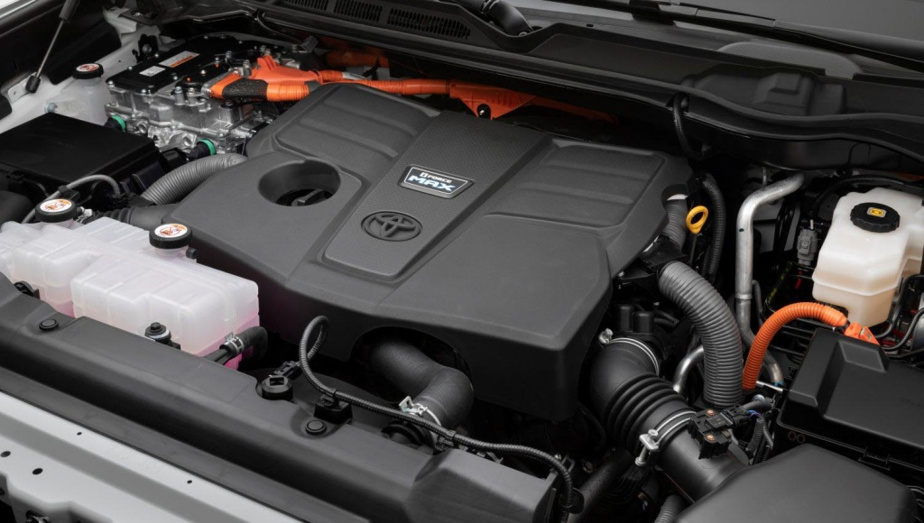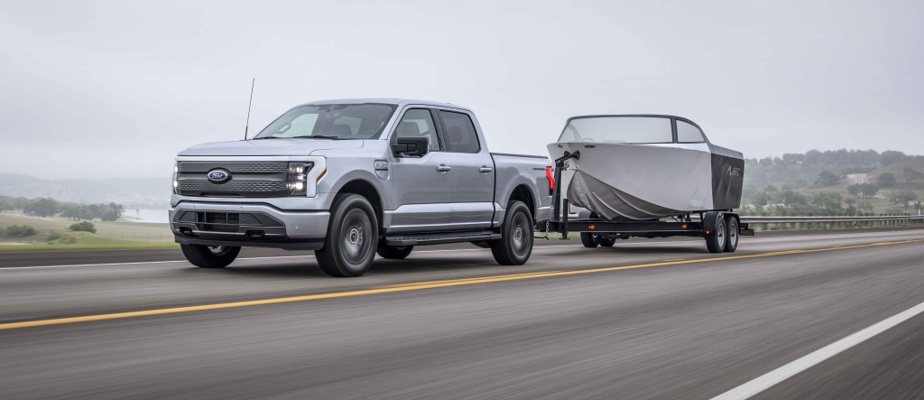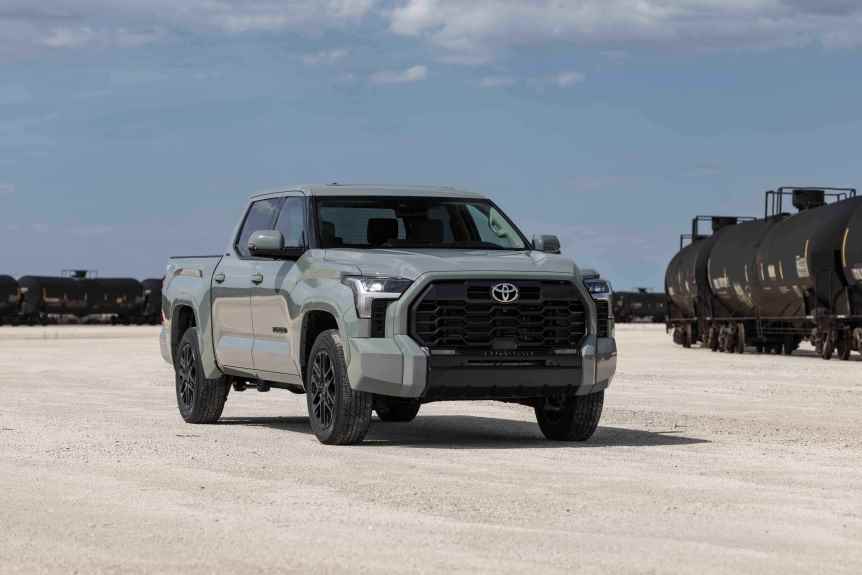Posted at 11:45 a.m.
The miracle did not happen
Faced with its competitors, the Tundra has – in the short term? — a serious asset. Since every liter of gasoline counts, it is one of the few in its class to offer a hybrid engine. This allows it to display more modest consumption, as long as there is nothing to shoot behind…
The loop is now closed. During the initial presentation of this new generation of pickup trucks, only one unit equipped with the hybrid engine was offered. Since we weren’t able to test it in good conditions, we chose to wait for its arrival on Quebec soil to measure its towing capacity (12,000 lb), but also its fuel consumption. Here are the results of our tests.
-

PHOTO PROVIDED BY TOYOTA
In theory, the Tundra Hybrid is all good. In practice, it is different.
-

PHOTO PROVIDED BY TOYOTA
The Toyota Tundra Hybrid starts at $66,390.
-

PHOTO PROVIDED BY TOYOTA
The infotainment system has been successfully remodeled.
-

PHOTO PROVIDED BY TOYOTA
Up front, the seats provide acceptable comfort.
-

PHOTO PROVIDED BY TOYOTA
In the back, the bench can seat three people, without them feeling too stuck.
-

PHOTO PROVIDED BY TOYOTA
The Tundra has a towing capacity of 12,000 lbs.
-

PHOTO PROVIDED BY TOYOTA
It may seem difficult to adapt to the braking at first, but as the kilometers go by, it is easily manageable.
-

PHOTO PROVIDED BY TOYOTA
The Tundra can be driven in tow mode (Tow/Haul), multi-terrain mode (MTS) or with downhill assistance and low-speed control (DAC/Crawl), an option that will appeal to off-road driving enthusiasts.
1/8
In theory, the Tundra Hybrid is all good. In practice, it is different. Over more than 1,000 km with a 7,200 lb trailer pinned to its back, this Toyota consumed more fuel than a pickup truck with a naturally aspirated V8 engine.
Compared to a RAM 1500 powered by the 5.7 L harnessed to the same trailer, taking the same route and in comparable weather conditions, the Tundra Hybrid ingests 19.3 L/100 km. Its American rival displays 18.2 L/100 km.
On the other hand, relieved of its load, the Tundra Hybrid absorbs much less gasoline. Compared to the RAM 1500 again, there is a saving of 3.3 L/100 km. Therefore, considering (alas) that many large format vans circulating on our roads are never used to their full potential, Toyota’s proposal makes sense. However, we regret that this thruster combining a supercharged six-cylinder engine with an electric power unit is only offered on the most elite (read the most expensive) versions of the range. At least for now.
Beyond consumption, remember that this hybrid engine is not only more flexible than the V8 that sat under the hood of the previous generation, but also less out of breath.
The automatic transmission that accompanies it perfectly smooths the reports and it will be criticized for its harshness in the deceleration phases. On this subject, the braking may seem difficult to modulate at first, but over the kilometers, you adapt easily.
In terms of behavior, this generation of Tundra is much more comfortable than the previous version and almost as well suspended as its main rivals. However, the rear axle sways too easily on bumps. As for the direction, soft and light, it cannot make forget the obstruction of this van. This one experiences difficulties both in maneuvers at low speed and when it comes time to park it (large turning circle).
A bit too much
At the front, occupants can stretch their legs (the driving position is fairly comparable to that of a sedan, but boarding is less easy). The seats provide acceptable comfort and the controls, despite their number, are generally easy to identify and locate. On this subject, let’s highlight the (successful) redesign of the infotainment system. This is much faster and above all more user-friendly than before. On the other hand, for such a modern vehicle, how to explain the presence of an interior button to unlock the valve of the petrol tank whose mouth is always surmounted by a cap?
That said, the storage is plentiful and practical while visibility is excellent. There is also the uneven quality (and sometimes fragility) of the plastics used to dress the cabin.
In the back, the bench seat can seat three people without them having to elbow their way too much. The seat lifts up, but the components hidden underneath limit the space available. This explains the mention “narrow cabin” in our “we like less” section of the technical sheet.
Toyota Tundra Hybrid
- Price: from $66,390 to $84,150
- Visible in concessions: limited offer
- Consumption: 11.4 L/100 km
WE love
- Fuel consumption gain without coupling
- Improved ride comfort
- User-friendly and thoughtful infotainment system
We love less
- Hybrid version limited to the most expensive versions
- Consumption when the vehicle is hitched
- Tight cabin
Our Verdict
The magic of the hybrid does not always work.
Technical sheet

PHOTO PROVIDED BY TOYOTA
The Toyota Tundra Hybrid is powered by a 3.5L i-Force Max hybrid turbocharged V6 engine.
Engine
- 3.5L V6 Turbocharged Hybrid (i-Force Max)
- 437 hp at 5200 rpm
- 583 lb-ft of torque at 2400 rpm
Performance
- Weight (minimum-maximum): 2725 kg
- Ground clearance (minimum-maximum): 236.2 mm — 238.7 mm
- Maximum towing capacity: 5443 kg
Box of gears
- Standard: 10-speed automatic
- Optional: none
- Drive mode: 4×4
Tires
- 285/65R18 (standard)
- 265/70R18 (TRD Off-Road)
- 265/65R20 (TRD Pro)
Tank capacity and gasoline recommended
Dimensions1
- Wheelbase: 3701mm, length: 5934mm, height: 1984mm, width: 2032mm2
1. Exterior mirrors excluded
2. The dimensions listed correspond to the Limited CrewMax version with 5.5 ft box.
Savings at the pump

PHOTO PROVIDED BY TOYOTA
Toyota has mastered hybrid technology perfectly.
Perfectly mastered by Toyota, hybrid technology allows, on passenger vehicles, to achieve real savings at the pump. On the other hand, its performance on a vehicle intended (generally) for professional use appeared less convincing. However, anyone who buys a full-size pickup truck for occasional recreation will benefit from fuel consumption that is often equivalent to that of a mid-size SUV.
another option

PHOTO PROVIDED BY FORD
The F-150Lightning XLT
In light of this test, hybrid technology does not save money at the pump when the Tundra has to tow a load (see text). Rival brands, including Ford, will soon offer another option with the launch of the F-150 Lightning. A pickup truck with an all-electric drive. Is this the solution? According to American colleagues, the F-150 Lightning could only tow a weight equivalent to the trailer used in our test bench over a maximum distance of 201 km.
Share your experience
The Press will soon publish the test of the following vehicles: Audi Q4 e-Tron, BMW 2 Series, Genesis G80, Honda HR-V, Land Rover Defender, Lexus RX. If you own one of these vehicles, we’d love to hear from you.

